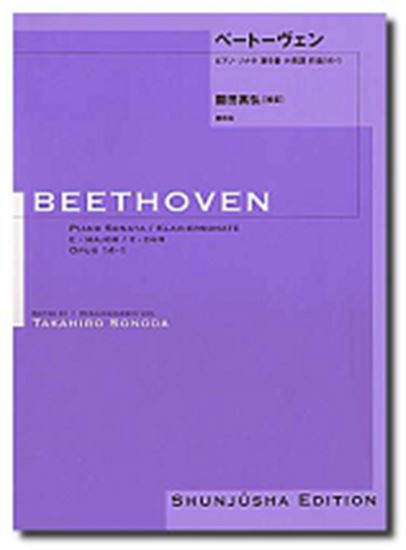Beethoven, Ludwig van : Sonate für Klavier Nr.9 E-Dur Op.14-1
Work Overview
Publication Year:1799
First Publisher:Mollo
Instrumentation:Piano Solo
Genre:sonata
Total Playing Time:14 min 30 sec
Copyright:Public Domain
Commentary (1)
Author : Okada, Akihiro
Last Updated: January 1, 2009
[Open]
Author : Okada, Akihiro
Although begun after the composition of the preceding work, the 'Pathétique' Sonata, Op. 13, it is stylistically quite distinct. That Beethoven himself arranged this work for string quartet is highly appropriate, given the four-voice texture evident in each movement, even if it was commissioned.
It should be noted that the string quartet version is written in F major, suggesting that the key of E major may still not have been common. This is because, in the Classical period, keys with four or more sharps/flats in the key signature were generally avoided as primary keys due to issues such as instrument tuning.
First Movement: E major, 4/4 time, Sonata form
Exposition
The principal theme, characterized by leaping intervals, is presented over arpeggiated chords. After a transition developing the theme's establishment, two secondary themes are presented in B major. First, a theme with descending and ascending stepwise motion appears, followed by a somewhat lively theme adorned with turns. In the codetta, the principal theme is restated.
Development and Recapitulation
The principal theme from the codetta develops and modulates to A minor. After a series of transitional phrases, the principal theme appears in E minor, preparing for the recapitulation.
The principal theme is restated in the tonic key over a two-octave scale passage. To restate the secondary themes in the tonic key, the transition first moves to C major, then leads to a half cadence on the dominant via an augmented sixth chord in E major (a doubly diminished dominant with a lowered fifth). Thus, the secondary themes are restated in the tonic key, and the movement concludes with a reminiscence of the principal theme.
Second Movement: E minor, 3/4 time
This movement has an intermediate character, resembling both a minuet and a scherzo. The main section features a theme based on octave unisons. The middle section is marked Maggiore (major) and is in C major, a third below the tonic, rather than the parallel major.
Third Movement: E major, 2/2 time, Rondo
The octave theme is presented over a triplet accompaniment. After a transition featuring rapid stepwise descending figures and four-voice crossing, a new theme is presented in B major. This theme is characterized by intervallic features such as a perfect octave, a descending diminished fourth leap, and ascending minor second and perfect fourth intervals.
After the opening theme returns in the parallel minor, it modulates to G major, its relative major. Here, the triplets, which were originally the accompaniment figure for the theme, become prominent, followed by transitional phrases. The third scale degree, B, is prolonged, and through this, the two themes are restated in B major. Subsequently, the opening theme develops as a coda, bringing the movement to a close.
Movements (3)
PTNA & Partner Channel Videos(5items)
Sheet Music
Scores List (14)

(株)全音楽譜出版社

(株)春秋社

(株)春秋社

(株)全音楽譜出版社

(株)全音楽譜出版社

(株)全音楽譜出版社

ヘンレ社(ヤマハ)

(株)音楽之友社

Barenreiter






![ベートーヴェン・ピアノ作品集2 ソナタ集[歴史的注解付批判校訂版] - 楽譜表紙画像](https://ptna-assets.s3.ap-northeast-1.amazonaws.com/enc/books/127.jpg)



